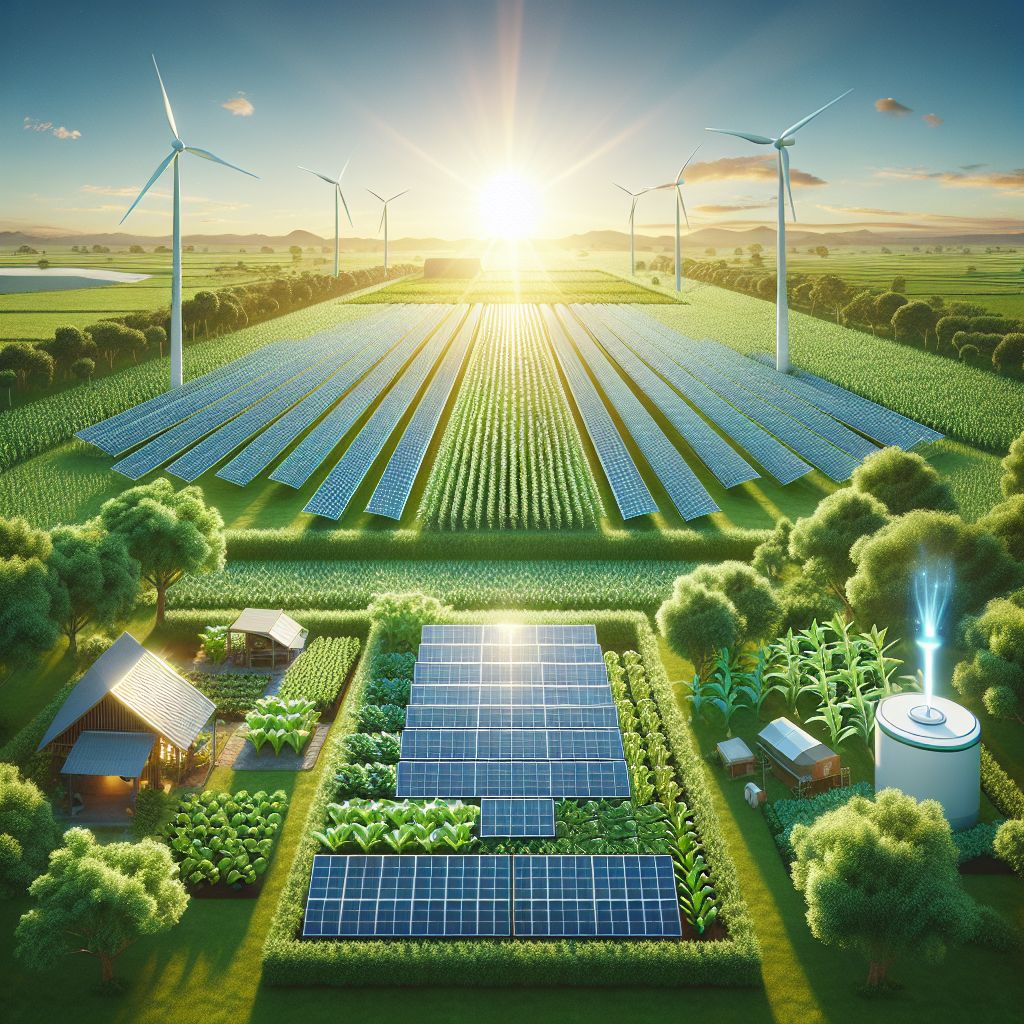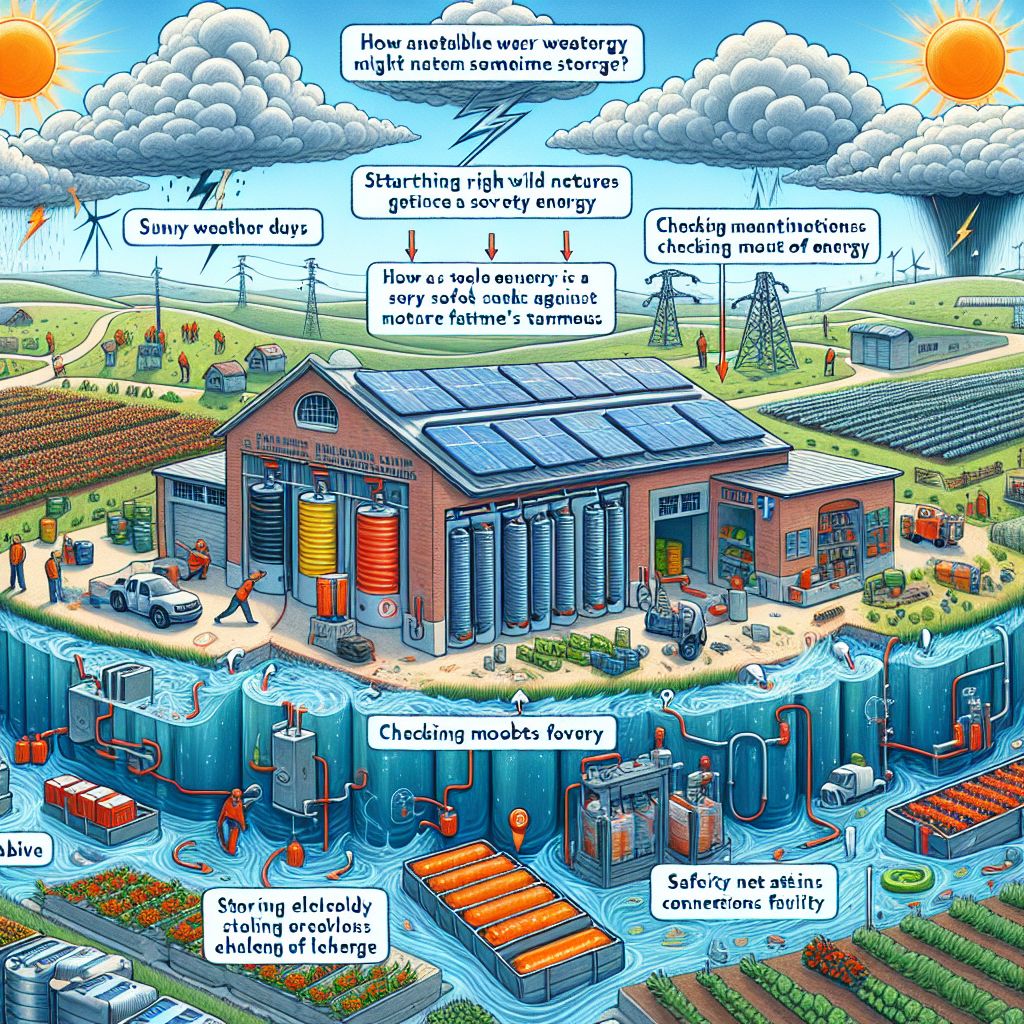
Key Takeaways
-
Flow batteries are a cutting-edge solution for energy storage, allowing farms to operate more sustainably.
-
They’re particularly well-suited for pairing with renewable energy sources like solar and wind power.
-
Choosing the right size and integrating flow batteries with existing systems is crucial for efficiency.
-
Reliable energy storage with flow batteries can lead to better crop yields and protection against power outages.
-
While the upfront costs can be significant, the long-term savings and potential government incentives make flow batteries a smart investment for the future of farming.
Sustainable Farming with Efficient Flow Battery Technology
Imagine a farm where the sun and wind work together, not just to grow crops, but to power the entire operation. This isn’t a distant dream—it’s a reality made possible by efficient flow battery technology. It’s a game-changer for those of us who believe in farming that’s as kind to the earth as it is productive. So let’s dive into how this technology can revolutionize the way we farm.
What is a Flow Battery?
A flow battery is like a magical box that stores electricity, but it’s not just any box—it’s one that keeps the energy flowing, quite literally. Inside, there are liquids called electrolytes, which contain energy. These electrolytes flow through the battery, creating a charge by moving from one tank to another. It’s like having a bucket brigade, but instead of water, they’re passing along energy.
Why does this matter for farming? Because flow batteries can store a lot of energy for when you need it most. They’re like a reservoir of power for your farm’s driest days.
Why Sustainable Farming Needs Efficient Energy Storage
Now, you might wonder why we’re fussing over energy storage when there’s a whole sky full of sun and acres of land for wind turbines. The answer is simple: the sun doesn’t shine all the time, and the wind doesn’t blow on demand. We need a way to keep that energy until it’s time to water crops or run the farm equipment, and that’s where flow batteries shine.
Most importantly, using flow batteries means we can reduce our reliance on non-renewable energy sources. This not only helps in cutting down greenhouse gas emissions but also makes our farms more resilient to energy price fluctuations.

The Heart of the Farm: Setting Up Your Flow Battery System
Setting up a flow battery system is like giving your farm a heart transplant. It’s the core of your farm’s new energy system, pumping life whenever it’s needed. But before we get our hands dirty, we need to plan.
Selecting the Right Size Flow Battery for Your Farm
Size matters when it comes to flow batteries. Too small, and you won’t have enough power when you need it. Too big, and you’re wasting money on unused potential. Here’s what you need to consider:
-
Energy needs: How much power does your farm use daily? Look at your energy bills or use an energy monitor to get a clear picture.
-
Renewable energy production: How much energy can your solar panels or wind turbines generate? This will help you determine how much storage you need to cover the gaps.
-
Future expansion: Are you planning to grow your farm? Make sure your system can grow with you.
This below table is showing you what you need to consider while thinking about purchasing the right size flow battery for your farm:
|
Consideration |
Details |
|---|---|
|
Power Requirements |
Determine the amount of power needed to run your farm equipment and facilities. |
|
Energy Storage Capacity |
Assess the amount of energy you need to store to ensure continuous power supply, especially during low energy production periods. |
|
Physical Space |
Consider the available space for the battery installation. |
|
Environmental Conditions |
Evaluate the temperature and other environmental factors that may affect the battery’s performance. |
|
Longevity and Maintenance |
Look into the expected lifespan of the battery and the maintenance requirements. |
This table provides a basic outline of the key factors to consider when selecting a flow battery for your farm. For more specific guidance, it is advisable to consult with a professional in the field of energy storage and agricultural technology.
Once you’ve got a handle on these points, you’ll be in a good position to choose a battery that fits just right.
Integrating Flow Batteries with Solar Panels
Flow batteries and renewable energy sources are a match made in heaven. The key is to integrate them seamlessly so that they work together to keep your farm running smoothly. This means connecting your solar panels to your flow battery so that excess energy is stored for later use.
It’s a bit like cooking a big meal and saving some for leftovers—except these leftovers power your farm instead of filling your belly.
Safe Installation Practices
When it comes to installation, safety is paramount. Always work with certified professionals who know their way around a flow battery. They should ensure that:
-
The system is installed away from high-traffic areas to avoid accidents.
-
All electrical connections are secure and meet local regulations.
-
There’s an emergency plan in case something goes wrong.
Think of it as strapping on a safety belt before taking your farm on a journey to sustainability.
Automating Farm Operations with Reliable Power Supply
With a reliable flow battery system, automating your farm operations becomes a breeze. Imagine irrigation systems that turn on precisely when your crops need water, without you lifting a finger. Or climate controls in your greenhouses adjusting automatically to keep temperatures just right. This isn’t just about convenience; it’s about using energy efficiently and reducing waste.
And here’s the kicker: because flow batteries can store energy so well, you can run these automated systems even when the sun has set or the wind isn’t blowing. That means your farm keeps humming along, powered by the clean energy you harvested during the day.
So, how do you make this happen? Start by mapping out your farm’s daily routines. Then, work with a tech-savvy electrician to set up timers and controllers that tap into your flow battery’s power. It’s a bit like setting an alarm clock, but instead of waking you up, it wakes up your farm operations.
-
Set up timers for irrigation to match the best times for plant absorption.
-
Use energy management systems to monitor and adjust energy use.
-
Automate feeding systems for livestock to ensure they’re fed even when you’re not around.
By doing this, you’re not just making your life easier; you’re setting up your farm to run like a well-oiled machine, all thanks to the power of flow batteries.

The Economic Benefits of Flow Batteries in Agriculture
The economic benefits of flow batteries in agriculture are numerous and significant. From reducing energy costs and increasing efficiency to promoting environmental sustainability and creating new job opportunities, these batteries have the potential to greatly benefit the agricultural industry. As the demand for renewable energy and sustainable farming practices continues to grow, the use of flow batteries in agriculture is likely to become more prevalent, bringing even more economic benefits to farmers and their communities.
Long-Term Savings on Energy Costs
Let’s talk numbers, because at the end of the day, farming is a business. Investing in a flow battery might seem like a hefty expense upfront, but the long-term savings are where you’ll see the real benefits. Here’s the deal: flow batteries have a longer lifespan than traditional batteries, and they can handle more charge and discharge cycles without losing their oomph.
That means you won’t be replacing them as often as you would with conventional batteries. Plus, they allow you to use more of the energy you generate instead of selling it back to the grid for pennies on the dollar. It’s like putting money in the bank and watching it grow with interest.
Government Incentives and Grants for Renewable Energy
Now, don’t forget to look into the sweeteners that can make the deal even sweeter. Many governments offer incentives, rebates, or grants for farms that adopt renewable energy technologies. It’s their way of saying, “Hey, we like what you’re doing for the planet, let’s help you do more of it.”
These incentives can significantly reduce the initial cost of setting up a flow battery system. It’s worth doing a little homework to see what’s available in your area. You might find that the cost of getting started is much less than you thought.
Increased Farm Valuation with Advanced Technology
Think about the future for a moment. If you ever decide to sell your farm, having a state-of-the-art energy storage system could seriously boost its value. It’s an investment that pays off in the present with energy savings and in the future with increased property value.
Buyers are looking for farms that aren’t stuck in the past, and showing them a slick, modern flow battery setup could be just the thing that seals the deal.
Other Benefits of Flow Batteries in Agriculture
Besides the economic upsides, flow batteries have a bunch of other benefits. They’re kinder to the environment than fossil fuels, they reduce the carbon footprint of your farm, and they can even improve the reliability of the local power grid by providing energy when it’s needed most.
And let’s not forget the feel-good factor. Knowing you’re doing your bit for the planet while growing your crops is a pretty sweet bonus.

Navigating the Challenges of Flow Battery
Dealing with Weather Variability and Energy Storage
Weather is as unpredictable as a game of bingo, and it can throw a wrench in the works of energy storage. But don’t worry, flow batteries have got your back. Their ability to store large amounts of energy means you can keep your farm running even when Mother Nature is having a mood swing.
It’s all about being prepared. On sunny or windy days, your flow battery will fill up with excess energy. Then, when the weather turns, you’ve got a reserve of power to keep things going. It’s like having a pantry stocked full of food, no matter what the weather’s doing outside.
Maintenance Requirements for Flow Batteries
Now, I won’t sugarcoat it: like any piece of equipment, flow batteries need some TLC to keep them in tip-top shape. But the good news is that they’re generally lower maintenance than other battery types. You’ll need to check on things like electrolyte levels and make sure connections are tight, but you won’t be doing this every day.
Think of it as like checking on your animals or giving your tractor a once-over. It’s just another part of regular farm upkeep.
Scaling Up: Expanding Your Energy Storage as Your Farm Grows
As your farm grows, so can your flow battery system. It’s not a one-size-fits-all deal; it’s more like a set of building blocks that you can add to over time. This scalability means you can start small and expand your energy storage capacity as your farm’s needs grow.
This below table will show the challenges for flow batteries integration onto a farm include:
|
Challenge |
Details |
|---|---|
|
High Initial Costs |
Flow batteries can have high initial investment costs, partly due to the expensive and sometimes corrosive or toxic fluids used in the system. |
|
Balance of System Costs |
In addition to the cost of the battery itself, the balance of system costs for flow batteries can be relatively high, along with the parasitic load needed to power the pumps. |
|
Competition with Lithium-Ion Batteries |
Flow batteries face tough competition from lithium-ion batteries, which have a well-established market presence and a rapidly declining cost curve. |
|
Limited Market Share |
Flow batteries have a relatively small market share compared to lithium-ion batteries, which may limit their widespread adoption in the agricultural sector. |
|
Lack of Standards |
The lack of standards for the development of flow battery systems can be a restraint, as it may lead to variations in performance and compatibility. |
These challenges highlight the need for further research and development to address cost, market competition, and standardization in order to fully realize the potential of flow batteries in agricultural applications.
So, as you add more crops or livestock, or even start processing your produce on-site, your flow battery can grow right alongside your business. It’s flexible, and that’s exactly what you need in the ever-changing world of farming.
Eco-Inspiration: Success Stories
Now, let’s get inspired by some real-life success stories. These aren’t just tales; they’re proof that flow batteries are making a difference in the world of agriculture.
Eco-Inspiration: Success Stories
Seeing is believing, and nothing illustrates the potential of flow batteries in agriculture better than the stories of those who have already taken the leap. Let’s look at a couple of farms that are reaping the benefits of this technology.
Case Study: The Flow Battery-Powered Vineyard
Out in sunny California, a vineyard has decided to pair its grapevines with flow batteries. This vineyard now uses solar panels to collect energy during the day, which is then stored in flow batteries. Even after the sun sets, the stored energy keeps the irrigation systems and climate control in the wine cellars running smoothly. The result? A bountiful harvest and a reduced carbon footprint, all thanks to the foresight of integrating flow batteries.
Case Study: Dairy Farms and Renewable Energy Storage
Switching scenes to a dairy farm in Vermont, where chilly winters could easily disrupt operations. By installing a flow battery system, this farm stores excess wind energy generated during gusty days. Now, even in the depths of winter, the farm maintains a consistent energy supply, ensuring that the milking equipment and refrigeration units never skip a beat. This farm not only saves on energy costs but also boasts an uninterrupted production line, all while contributing to a greener future.
FAQs
How Do Flow Batteries Differ from Traditional Batteries?
Flow batteries stand out from traditional batteries in several ways. They use liquid electrolytes that flow through a cell to generate electricity, which means they can be recharged simply by replacing the electrolyte. They’re also more scalable and have longer lifespans, making them a better fit for large-scale operations like farms.
Can Flow Batteries Work in Any Climate?
Absolutely! Flow batteries are versatile and can operate in a wide range of climates. Whether you’re dealing with the scorching heat of the desert or the freezing cold of the highlands, flow batteries can be configured to withstand extreme temperatures and keep your farm powered all year round.
What Are the Upfront Costs of Flow Battery Installation?
The upfront costs for installing a flow battery system can vary widely depending on the size of your farm and energy needs. Generally, you might expect initial investments to range from tens of thousands to hundreds of thousands of dollars. However, with potential government incentives and the promise of long-term savings, the initial sticker shock is often mitigated over time.
How Do I Manage the Energy Supply from Flow Batteries?
Managing the energy supply from flow batteries involves monitoring your energy production and consumption. You’ll want to use smart controllers to optimize when and how the stored energy is used, ensuring that your farm’s operations are powered efficiently. Regular maintenance checks will also help you keep the system running smoothly.
Are There Specific Crops That Benefit More from Flow Battery Usage?
While flow batteries can benefit a wide array of crops by providing consistent and reliable energy for irrigation and other needs, those that require precise climate control, like certain fruits and vegetables grown in greenhouses, may see the most direct benefits from such an energy storage system.
Conclusion: Is Flow Batteries a Good Investment for a Farmers Solar Irrigation System?
In conclusion, investing in flow batteries for your solar irrigation system is a smart move for the future of farming. The technology not only helps in achieving sustainability goals but also provides economic benefits through energy cost savings and potential increases in property value. By embracing flow batteries, you’re not just nurturing your crops; you’re nurturing the planet and paving the way for a greener, more resilient agricultural industry. It’s a step towards a future where farms are powered by the very elements they thrive under: the sun, the wind, and the ingenuity of those who till the land.






